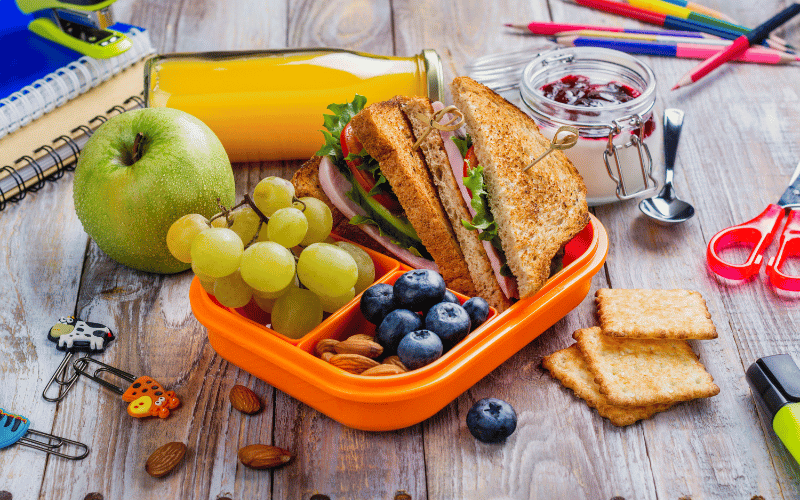Introduction: The Art and Science of Packing a Healthy Lunchbox
Assembling a nutritious and appetizing lunchbox that your kids will love is no minor feat. But fear not, we’ve got you covered. In this comprehensive guide, we will explore the essential building blocks of a healthy lunchbox and offer you an abundance of creative meal ideas for kids. Let’s dive right in!

Understanding the Nutritional Needs of Children
Children have unique nutritional needs that fuel their growth, learning, and play. A well-balanced lunchbox should reflect these needs, providing an optimal mix of carbohydrates, proteins, fats, and essential vitamins and minerals.
Proteins: The Body’s Building Material
Proteins are indispensable for growth and repair of body tissues. Include lean meats, poultry, fish, eggs, or plant-based alternatives such as beans, lentils, and tofu in your child’s lunchbox.
Carbohydrates: The Body’s Energy Source
Carbohydrates are the body’s primary source of energy, crucial for fueling active bodies and alert minds. Whole grains like brown rice, quinoa, or whole-wheat bread are excellent sources of complex carbohydrates.
Healthy Fats: Brain and Body Boosters
Healthy fats are essential for brain development, hormone production, and overall health. Avocado, nuts, seeds, and oily fish are great options to ensure your child gets their share of healthy fats.
Vitamins and Minerals: The Body’s Spark Plugs
Vitamins and minerals aid in myriad bodily functions, from boosting immunity to supporting bone health. Fresh fruits, vegetables, dairy, and lean proteins are rich in these crucial nutrients.
Let’s Get Creative: Lunchbox Meal Ideas
Now that we have the nutritional basics down, let’s explore some creative meal ideas that will make your child’s lunchbox a delightful surprise every day.
Delectable Wraps and Rolls
Wraps and rolls are versatile, easy to make, and fun to eat. Fill a whole grain wrap with lean proteins like chicken, turkey, or tofu, and add a rainbow of veggies. Experiment with various dips and spreads to keep things interesting.
Colorful Pasta Salads
Pasta salads can be a hit with kids. Choose whole grain pasta and toss it with a variety of colorful veggies, lean proteins, and a healthy dressing. Bonus: It tastes great warm or cold.
Finger-Licking Kebabs
Who doesn’t love food on a stick? Skewer chunks of lean meat, tofu, or cheese with a variety of veggies and fruits. They’re fun to eat and pack a nutritional punch!
Hearty Soups
A thermos of warm, hearty soup can be comforting and nourishing. Chicken noodle, minestrone, or a simple vegetable soup can be paired with a side of whole grain bread or crackers.
Snack Time: Healthy Munchies
Snacks can be nutritious and satisfying additions to your child’s lunchbox. Here are a few ideas:
Fruit and Yogurt Parfaits
Layer Greek yogurt with fresh fruits and a sprinkle of granola for a protein-rich snack.
Veggie Sticks and Hummus
Slice cucumbers, bell peppers, and carrots, and pair them with a serving of protein-rich hummus.
Homemade Trail Mix
Mix nuts, seeds, dried fruit, and a sprinkling of dark chocolate chips for a quick, energy-dense snack.
Hydration Station: Don’t Forget the Drinks
Hydration is key to keeping kids energized and focused.
Infused Water
Infuse water with slices of fruits like strawberries, oranges or lemons for a fun twist on regular water. This encourages kids to keep sipping throughout the day.
Smoothies
Whip up a smoothie using Greek yogurt, fruits, and a handful of spinach or kale. It’s a delicious way to sneak in some extra nutrition.
Tips for Assembling a Healthy Lunchbox
To wrap up, let’s look at a few practical tips to make packing lunchboxes easier and more effective.
Variety is the Spice of Life
Rotate your menu to keep things exciting. If your child loved the pasta salad this week, try the wraps next week.
Involve Kids in the Process
Get your kids involved in meal planning and preparation. They’ll be more likely to eat food they’ve helped create.
Keep it Colorful
A colorful lunchbox is more visually appealing and ensures a variety of nutrients. Aim for a rainbow of fruits and vegetables.
Pay Attention to Portions
Ensure you’re packing the right amount of food. Too much can be overwhelming, and too little can leave kids hungry.
Conclusion: Building a Better Lunchbox
In conclusion, building a healthy lunchbox is a blend of nutritional knowledge and creative food assembly. By keeping your child’s nutritional needs in mind and mixing up your meal ideas, you can create appetizing, balanced lunchboxes that your kids will be excited to eat. Remember, the key is to make healthy foods fun and engaging for your child.